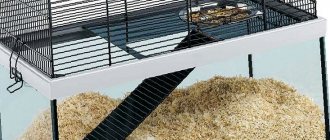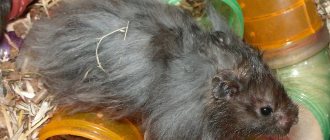December 7, 2021
We've thought of everything: the perfect couple of days in Almaty
Read November 26, 2021
I'm in Almaty, and you?
Read November 18, 2021
More please: how to save money when traveling
Read November 16, 2021
Russia resumes flights with five countries it almost never flew to before
Read November 11, 2021
The authorities want to introduce QR codes for traveling around Russia. How will it work?
Read November 8, 2021
How to have fun in Goa
Read
If you decide to fly with a tiny friend, you need to know the transportation rules. With small animals everything is more complicated than with cats and dogs. And spoiler alert: some disappointing news awaits you.
Almost all carriers are loyal to dogs and cats on board, but with small pets it is more difficult. For example, S7 does not allow the transport of rodents, fish, reptiles and arachnids. In general, not at all and under no circumstances.
S7 Airlines response
S7 Airlines can only transport cats, dogs and birds.
Therefore, before purchasing a ticket, check with the airline: you can or cannot carry it and what the conditions are. Agree on a solution with the carrier at least 48 hours before departure. And read the rules and tips for transporting animals.
Is it possible to do without carrying?
It should be remembered that carrying is not someone’s whim, but a necessary measure. It is not safe to transport a rodent in a jar or even in your hands; it is not always possible to transport a huge cage.
If the animal does not leave its habitat, there is no urgent need for carrying. You can buy it for trips to the veterinarian so that the animal does not get hurt on the way, but this item is best suited for owners who go on a trip with a rodent.
This device will ensure his safety and reduce the stress of the trip. Owners do not have to worry that the animal will run away, freeze or get hungry - everything is provided in the carriers.
The rodent gets used to certain smells and sounds.
Documents for air travel with animals
Regardless of whether you are flying with a parrot or a goldfish, your pet must have the necessary package of documents:
- Veterinary passport.
- International veterinary certificate (for foreign flights).
- Veterinary certificate in form No. 1 (for domestic Russian ones).
- Microchipping certificate.
- Documents required by the legislation of the country of arrival (for example, a certificate of absence of infections, breeding value, etc.).
At the airport, before departure, your pet must go through control at the veterinary station.
First of all, check if the animal is listed in CITES https://www.cites.org/eng/app/appendices.php. If yes, you will have to obtain an individual permit for its export from Rosprirodnadzor.
Basic provisions for transporting hamsters
Pets do not tolerate any change of environment well. The rodent gets used to certain smells and sounds. Lighting and temperature changes also play a big role: any change can cause extreme stress in your pet. To avoid this, veterinarians recommend creating an atmosphere in the carrier that is familiar to the hamster.
First of all, some of the filler is poured out of the cage to create a familiar smell. It will be a good sign if the rodent buries itself in it and decides to sleep like that the whole way. A normal reaction is when the animal immediately marks a new refuge. Before the trip, you can let your pet get used to being carried, this will make it easier for him to endure the journey.
Dry food is used as food. It is not advisable to place water: there is a possibility that it will simply spill during transportation.
Important! To prevent your pet from dying of thirst, they give him a juicy vegetable, preferably fresh.
Hamsters do not tolerate very high or very low temperatures well.
Fish on the plane
The main difficulty with transporting fish on an airplane is that they live in water. And its volume, as a rule, exceeds 100 ml - the maximum limit for liquid in one bottle in the aircraft cabin.
Therefore, the vast majority of airlines refuse to transport fish.
Most likely, the aquarium fish will fly in the trunk
For example, Aeroflot airline is not ready to accept them in any form, just like rodents. If you can find a carrier that is prepared for such unusual passengers, most likely they will fly in the luggage compartment. Please note that airlines are not responsible for the safety of fish.
What to transport fish in
Aquarium fish are transported in a strong, sealed container without corners or dangerous elements. The most popular options are a jar, thermos or plastic container. However, it is better to use multi-layer sealed bags. This way, when shaking, the fish are not injured by the walls of the container. The package is placed in a box (usually foam).
Fish can stay in a bag of water and oxygen for up to 70 hours. With water and air - much less.
How to prepare for air travel of aquarium fish
The bag cannot be filled completely with water and oxygen; under pressure during the flight it may burst.
Rules for air travel of fish:
- Before the flight, the fish need to fill the aquarium with fresh water - preferably 3 degrees below the usual norm. This will make the journey easier for them.
- The fish are moved into containers or sealed bags before departure and the recently replaced water is poured into them. The ratio of water to air is 2:1.
- A more preferable option is to ask the pet store to fill the container with water, saturating it with oxygen at the same 1:2 ratio.
- Do not overfill the container with oxygen or air (the surface of the bag should be slightly pressed when pressed). At flight altitude, the pressure decreases and the volume of air increases.
- Before the trip, the fish are not fed for a day - well-fed fish consume more oxygen.
- Do not transport many fish in one container. At a minimum, 1 liter of liquid is required for one 5-centimeter individual.
- The container must be darkened - fish tolerate stress more easily in the dark.
- During the cold season it is necessary to provide heating. For example, cover a bag with waterfowl pets with heating pads.
Temperature
When transporting, owners should remember that hamsters do not tolerate very high and very low temperatures. In summer, you need to make sure that the animal carrier is not exposed to the sun. The rodent can overheat and even get sunstroke. It is advisable to keep the container with your pet somewhere in the shade. There should be enough space in the carrier for air circulation.
Important! You cannot leave your pet alone in a completely closed vehicle - it may overheat or suffocate.
In winter, the animal requires careful observation. It is very important to keep your rodent warm. You should not allow him to stay in the open air for a long time - the hamster will freeze and may become numb. There is no need to use heaters; instead, the owner can cover the container with a warm blanket and put napkins inside.
Plastic containers are considered the most reliable
Parrots and other birds on an airplane
After cats and dogs (read the rules for transporting them here), the most popular pet passengers are birds. First of all, because a much larger number of airlines are ready to accept them on board than, for example, fish or rodents. The parrot's flight must be coordinated with the airline no later than 48 hours before departure. And at the same time, find out the exact requirements for a container for transporting birds. The cage must be strong and have a secure lock. All accessories inside the cage (bowls, branches, toys) are secured (tied to the rods).
All toys and other accessories must be securely attached to the bars of the cage during the flight.
The bird can be transported in the cabin or luggage compartment. It’s better in the salon - the owner can correct the shortcomings in time and just talk to the pet. In addition, the luggage compartment has poor ventilation, which can cause serious injury to the bird.
Before the trip, you need to clarify whether it is possible to transport a cage with a bird on your lap, under the seat, or whether you need to buy an adjacent seat for it - the rules are different for all airlines.
How to prepare a bird for air travel
Birds are transported in a cage or carrier bag; it is better to introduce the pet to its temporary home in advance
. A few tips to help reduce the bird’s stress during air travel:
- To make it easier for your feathered pet to endure the journey, it must be accustomed to the cage in advance.
- You should bring a dark cloth with you to cover the cage during the flight (some airlines provide such a cover).
- If at home the parrot prefers to live a free life, before going on the road it is better to accustom it to a long stay in the confined space of the cage.
- Often a week before the trip, the bird is given stress vitamins. But only an ornithologist veterinarian should prescribe it.
- Before the flight, the bird should be given something to drink, and fresh, liquid-rich fruits should be placed in a bowl.
UniTicket recommends:
- Look for cheap air tickets on aggregators: UniTicket
,
Aviasales
and
Kiwi.com - Look for hotels on RoomGuru - this service compares prices across all booking systems, including Booking.com and Agoda.com .
- It is better to compare prices for rental cars on EcomonyBookings or Myrentacar
- Go on an unforgettable author's trip YouTravel
Features of containers
Each carrier should have small holes for air. Containers for food and water are also required. If you just bought a pet, then a cardboard box is suitable for transporting it home. It should be remembered that such a carrier is not at all reliable: after just a few minutes the animal can gnaw a hole in it and escape.
A glass container can be used for short distance transport, but you need to be careful with it. Plastic containers are considered the most reliable - the hamster will not chew them, and they will not be damaged too much if something happens.
The aircraft is not suitable for transporting rodents
How to transport rodents on an airplane
- Rodents are transported in certified factory containers.
- Some airlines reluctantly allow rodents on planes. In this case, the container must correspond to the dimensions of hand luggage. Check with the airline for size.
- It is necessary to provide documents from the veterinary clinic stating that the animal is healthy.
- Veterinary passport
- Chipping mark
- Veterinary certificate form No. 1 - for domestic flights
- International veterinary certificate - for international flights
- Additional package of documents upon request of the country of arrival
- Check if your little one is on the Rosselkhoznadzor list. If there is, then everything is fine. If not, you will need to obtain an individual import/export permit
What kind of cage is needed?
With a dense frame, good ventilation, no sharp corners and a reliable lock. It must also fit within the dimensions of hand luggage.
More important information
Rodents are potentially dangerous guys for an airplane. The dog won’t just get lost on board and crawl into some crevice. But a hamster - easily.
Many companies refuse to transport rodents. If you decide to travel with a hamster, be sure to check all the information with the carrier.
In addition, even if you manage to take your pet out, it is not a fact that upon arrival in another country it will also be greeted happily. Find out what the specific country's import regulations are.
Under no circumstances should you try to transport your fluffy in secret. This is fraught with consequences, and if the hamster is found, it may have to be left at the airport.
Transporting a hamster using different means of transportation
Transportation by wheeled transport
Hamsters tolerate this type of transportation the easiest. To transport a rodent within the country, no certificates are required; they are only needed when crossing the border. It is enough to purchase a comfortable carrier, provide the animal with enough food and water, and also make sure that it is not too cold or hot.
Important! If the vehicle does not have air conditioning, then in summer the animal should be transported in the evening, when the heat subsides. Windows must be open.
Air travel
The aircraft is not suitable for transporting rodents. Some of them cannot tolerate heavy loads. There is a high chance that pressure surges will cause the animal to have a stroke and die. Before traveling, the owner should consult a veterinarian about his pet. Experts say that flying is the worst for dwarf hamsters and Syrian hamsters.
In order for an animal to be allowed into the territory of another country, it is necessary to prepare the necessary documents and certificates in advance. Each airline may have its own requirements for transporting pets.
Important! For the owners, this means collecting numerous pieces of paper, and for the animal - a direct threat to its health. You should resort to this means of transportation only if there is no other way to get to your destination.
Have you ever traveled by plane with an animal?
Travel by rail
Transporting a hamster by train is not difficult. When purchasing a ticket, you must indicate the carriage of hand luggage and make sure that animals are allowed in the carriage. You must have a carrier with you. Small rodents can be transported without special documents.
Important! Transportation requirements change frequently, so please check with official sources before traveling.
In summer, the temperature on the train can be very high. The owner should try to take a ticket to a carriage with air conditioning to prevent the pet from being exposed to high temperatures.
Animal bags made of fabric are suitable if you need to transport the animal over a short distance.
“Hamster stories”: keeping a hamster according to all the rules
How do we choose our animals? Sometimes by accident, sometimes deliberately. Someone’s dream of a furry (and other) friend comes true immediately, while others pursue it for many years. Anna first saw a hamster in a pet store window: the baby fell asleep on the way to the feeder and looked incredibly cute and touching. Without thinking for a long time, she purchased two “jungarians” and a cage for them, but in reality keeping hamsters turned out to be not such a simple matter.
Djungarian hamsters are smaller than Syrian ones, but more nimble. Their diet is slightly different from the diet of their Syrian counterparts, but both species are united by common qualities: thriftiness and a tendency to gnaw on everything they can get their teeth on. Anna was in no hurry with names. I wanted the name to match the appearance or character of the pet.
Photo: @fluffygrains
So one became Mouse due to his external resemblance, and the second became Syoma, because he resembled a grain in a fluffy shell. The resemblance to seeds, by the way, gave the name to the Djungarians’ Instagram account – @fluffygrains.
Building a house for a hamster
Like any animal, hamsters have their own characteristics. As it turned out, everything is not so simple, and the knowledge shared by the pet store sellers was not enough. Later, the owners read on the Internet that hamsters are territorial animals, and each of them needs their own cage, and by this time Mouse and Syoma had already managed to sort things out several times.
By the way, buying a suitable cage is also not an easy task. A cage with soft bars can encourage your pet to escape: the Djungarian tandem had the experience of an almost successful escape, and some subscribers had a successful one. The fugitive had to be lured out from under the floor with treats for a month. A small (less than 60*40*30) cage does not allow the hamster to move enough. If we take into account that the baby’s entire life, with rare exceptions, is spent in a cage, then the situation looks quite sad. Give your pet a little more space and keep in mind that even a small hamster grows at first.
K-C5/40691035 Cage for small animals, enamel, 610x460x450mm*2
Take a look here too!
The hamster is naturally curious and fearless: protrusions and additional levels in the cage are an additional risk of injury for the animal. But pipes and manholes are absolutely necessary: in nature, the hamster is accustomed to digging tunnels in which it stores food supplies and places to rest. Systems of artificial tunnels create conditions for the hamster that are at least vaguely reminiscent of natural ones. By the way, good tunnels are made from toilet paper rolls - cheap and cheerful
In addition to cages, there is another way to place a rodent in the house - a dune, a box made of plastic or polymer glass with a mesh lid. The dunes are comfortable, ergonomic and minimize the risk of escape, but leave the question of the pet's safety open. There are no completely transparent dunes for sale, and those that are presented in stores do not allow the owner to keep an eye on the pet.
Marathon on a wheel
A running wheel should also be placed in the cage: hamsters are naturally energetic and love movement. In addition to wheels, the hamster can be offered hay tunnels (food toys that are gradually chewed off and serve as both food and entertainment), nests, branches and holes, but the wheel still remains a priority. Choosing a wheel is also not so easy: wooden models with a cork track are environmentally friendly and beautiful, but expensive
It is not necessary to spend a large amount at once, but making sure that your pet is comfortable is very important. The hamster must fit completely into the wheel, and there must be room in front and behind to accelerate to a running step.
Choosing a Carrying Bag
When purchasing a container for your hamster, you need to pay attention to several details:
- Carrying size. A small container is suitable for transportation. If the rodent requires a lot of free space, then you can choose a larger one.
- Material. Metal containers are practically no different from a rodent’s usual home and have a low cost. It is most convenient to use a plastic container - it is easy to wash, the hamster will not be able to chew through the hole, and there is enough light from above. Animal bags made of fabric are suitable if you need to transport the animal over a short distance.
- Price. There are both very cheap models and more expensive containers. You need to choose based on the financial capabilities of the owner and the necessary properties of the container. The main thing to remember is that low price = fragility and unreliability.
Brief overview of popular models
- Plastic. Easy to clean, you can observe the animal through the transparent top. Versatile: can be used for both short trips and long trips.
- Carrying bag. Made of dense fabric, ventilation and a window for observation are provided. The animal bag is suitable for transportation over a short distance.
- With metal rods. It resembles a familiar cage for a rodent, the most budget option. The bottom is made of plastic so that filler can be poured in and it is more convenient for the pet to move around the container.
You can do simple carrying yourself.
Execution order
For the bottom of the carrier, the same material is used as for the walls, but you can put fleece inside to make the pet softer and warmer, this is especially important for very young passengers. A cover is sewn from light fabric into which a rigid base is inserted, and then the whole thing is covered with the fabric used for sewing the carrying case.
4 identical parts are cut out from the selected material and sewn from the inside out so that the front side of the fabric remains visible from the outside. An additional external pocket can be attached to one of the outer walls; it can be useful for carrying things with your pet and will serve as another decorative element.
For the side triangular walls, which serve for carrying backwards and forwards, you will need a mesh. One of the walls is made of mesh for free breathing and visibility of the pet.
The finished parts of the bottom and all 4 walls are sewn together by machine or by hand, then the handles are attached to the carrier. It is necessary to secure the handles as best as possible so that they do not come off even if the animal begins to panic. For the same reason, it is better to use a long handle over your shoulder - this will make it less likely that the bag and your pet will slip out of your hands and fall. Inside you can attach some toys for the cat and things that can be chewed for the dog. After this, you can start using the carrier.
DIY hamster carrier
You can do simple carrying yourself. The material you can use is a plastic food container, bucket or bottle .
- It is necessary to ensure the integrity of the container and wash it if there is any contamination.
- You need to cut holes for air on the walls and lid.
- Pour filler or sawdust inside.
- If a handle is needed, two holes are made in the lid and a thread or rope is threaded through them.
Important! This type of carrier is only suitable for short-term transportation of a rodent. Due to weather conditions, your pet may feel uncomfortable in it.
Stages of work
STAGE 1 I WANT THIS PASSPORT
You roughly think through the design of what you want to see on the cover. We set tasks and deadlines for work.
STAGE 2 PREPARATION OF MATERIAL The customer prepares photographs, texts: name of the nursery, breed. telephone, e-mail and other contact information.
STAGE 3 DESIGN DEVELOPMENT We make 1-2 design options and present the layout to the client. We make adjustments as necessary.
STAGE 6 FINAL
The order is sent to the customer.
STAGE 5 PRINTING
The desired circulation is produced, the printing quality and product quality are checked.
STAGE 4 TECHNICAL STAGE
At this stage, the layout is prepared before printing. And transfer of the layout to the printing house for replication.











